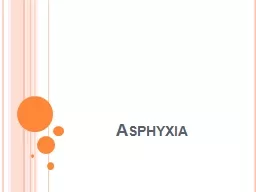

Severer deficiency of oxygen supplied to the body Often leads to Hypoxia Causes Airway Obstruction Choking on food Tongue rolling back to block airway ReducedImpaired exchange of gases in alveoli during fumessmoke inhalation ID: 784817
Download The PPT/PDF document "Asphyxia Asphyxia Medical term for suffo..." is the property of its rightful owner. Permission is granted to download and print the materials on this web site for personal, non-commercial use only, and to display it on your personal computer provided you do not modify the materials and that you retain all copyright notices contained in the materials. By downloading content from our website, you accept the terms of this agreement.
Slide1
Asphyxia
Slide2Asphyxia
Medical term for suffocation
Severer deficiency of oxygen supplied to the body
Often leads to Hypoxia
Slide3Causes
Airway Obstruction
Choking on food
Tongue rolling back to block airway
Reduced/Impaired exchange of gases in alveoli during fumes/smoke inhalation
Impaired function of lung(s)
Impaired breathing
Asthma
Slide4Hypoxia
Slide5Hypoxia
Medical term for low oxygen level in the blood stream
Slide6Causes
Insufficient oxygen in inhaled air
Suffocation by smoke or gas
Changes in atmospheric pressure e.g. high altitudes
Airway Obstruction
Choking by an external object
Lungs & Chest Injury
Punctured lung(s)
Collapsed lung
Reduced/Impaired oxygen uptake by tissues
Carbon monoxide poisoning
Cyanide poisoning
Slide7Signs & Symptoms
Rapid, distressed breathing and gasping for air
Confusion, irritability and aggression, leading to unconsciousness
Cyanosis
appearance of a blue or purple coloration of the skin due to the tissues near the skin surface being low on oxygen
Slide8Airway Obstruction
Slide9Causes
Tongue falling back in unconscious casualties
Food, Vomit, fluids in mouth or allergy
Swelling of throat
Spasm of respiratory muscles
Uncontrolled movement
Slide10Signs & Symptoms
Noisy, labored breathing
Difficulty breathing
Cyanosis
Flaring nostrils
Enlargement of nostrils
Increased effort in breathing
Reversed movement of chest and abdomen
Slide11Treatment
Ensure ABC
Assist casualty in removing any obstructions
Prepare to perform Heimlich
manoeuvre
or chest thrusts
Reassure casualty if conscious
Seek medical aid
Monitor Level of Response and vitals signs at least every 5 minutes
Slide12Hanging, Strangling, Throttling
Slide13Hanging, Strangling, Throttling
External pressure on the neck squeezing the airway, blocking flow of air to lungs
Hanging
Suspension
of body by noose around the neck
Strangling
Constriction
around neck
Throttling
Squeezing
of the throat
Slide14Signs & Symptoms
Constricting articles around neck
Marks around casualty’s neck
Rapid, distressed breathing
Cyanosis
Congestion of face with prominent veins
Not enough blood or oxygen
Slide15Treatment
Ensure ABC
Remove any constricting from the neck, ensuring safety of casualty is not compromised in any position
Reassure casualty if conscious
Seek medical aid
Monitor Level of Response and vital signs at least every 5 minutes
Slide16Treatment
DO NOT:
Destroy or interfere with any evidence especially
with ropes and the knots
Cut above the noose so as to not destroy evidence
Move casualty unnecessarily if spinal injuries suspected
Slide17Drowning
Slide18Drowning
Occurs not because lungs are filled with water
Water enters the airway, the vocal chords in the throat constrict and seal the airway
preventing the intake of oxygen
Best to throw casualty a float, without going into the water
Unless trained in lifesaving and casualty is unconscious
Carry the casualty with head below chest level when bringing an unconscious casualty out of the water to minimize further complications
Slide19Treatment
Ensure ABC
Lay casualty down on back, best on warm materials
(change wet clothing if possible)
Reassure casualty if conscious
Seek medical aid even if casualty is conscious and appears well
In case of secondary drowning
Pneumonia
Monitor Level of Response and vital signs at least every 5 minutes
Slide20Inhalation of Fumes
Slide21Inhalation of fumes
Breathing in of harmful gases, vapors, and particulate matter contained in smoke
Slide22Signs & Symptoms
Cyanosis
Distressed
Coughing and wheezing
Labored breathing
Headache or confused
Unconscious
Slide23Treatment
Ensure ABC
Remove casualty from area
Reassure casualty if conscious
Seek medical aid
Monitor Level of Response and vital signs at least every 5 minutes
Slide24Hyperventilation
Slide25Hyperventilation
Rapid or deep breathing which Is sometimes also called over-breathing
May leave you feeling breathless
Occurs faster than Hypoxia
Slide26Signs & Symptoms
Chest pains
Dizziness/Nausea
Cramps in hands and feet
Tingling
Attention-seeking
behavior
Slide27Treatment
Ensure ABC
MOVE CASUALTY AWAY FROM TRIGGER
Ask the casualty to take slow, deep breaths to calm down (seated down)
Monitor Level of Response and vital signs at least every 5 minutes
Slide28Asthma
Slide29Asthma
Medical condition in which the airway
Becomes inflamed and swollen
Through excessive mucus secretion (phlegm)
Breathing becomes difficult
Can be hereditary or environmental
Allergens
Viral/Bacteria infections
Chemicals
Emotional stress
Pollutants
Cold
Slide30Signs & Symptoms
Air hunger
Wheezing
Chest tightness
Using of auxiliary muscles
Cyanosis
Slide31Treatment
Reassure casualty
Remove casualty away from trigger if any
Encourage casualty to use inhaler if available
Fast-acting bronchodilators (e.g.
Ventolin
)
DO NT use preventive inhalers (e.g.
Beclotide
)
Ensure fresh air is available
Monitor Level of Response and vital signs at lest every 5 minutes
Prepare to perform CPR